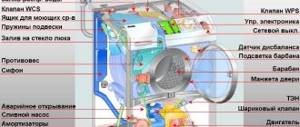In this article we will tell you how to make a laser alarm. The idea is to make such an alarm as shown in movies about superheroes.
This laser alarm simulates a stretch when a thin wire is stretched 20 centimeters above the ground (floor). When an intruder enters the protected area and pulls a tripwire, an alarm is activated. What if you do a laser alarm and a tripwire at once? That's right, this will turn out to be quite interesting.
The alarm system discussed in the article is primarily intended for use in airsoft, but it can also be used to protect residential premises, garages, etc.
The principle of operation of a laser pointer alarm is quite simple.
The PIC16F688 microcontroller controls the laser module that sends the beam, which must be returned through the mirror. The reflected beam is received by a photoresistor. The PIC16F688 microcontroller checks the state of the photoresistor and if the laser beam is blocked, it activates a sound signal.
The laser signaling circuit is quite simple and is shown in the following figure:
To change operating modes, use switch S3 - select the operating mode: laser and / or stretch:
- Laser + stretching.
- Stretching.
The photoresistor must be placed inside the tube to prevent it from being exposed to sunlight or other light sources. To eliminate the possibility of accidental activation of the laser alarm.
And the laser pointer needs to be modified by soldering the wires to the place where the batteries are installed.
The following figure shows the laser module and photoresistor tube.
To combine both elements, they must be aligned and glued together, for example, by cold welding or plastic. Thus, they are assembled parallel to each other.
For the stretch version, a microswitch is used, located in the upper part of the laser alarm housing. The mikrik lever protrudes above the body, through the window, so that fishing line, thread or thin wire can be hooked onto it.
Now you can finally finish the case by making holes for the LEDs, power button, mode switches and siren.
When installing the emitter with the receiver, please note that it must be possible to adjust this part of the laser alarm.
The alarm uses a modified portable PC beeper because it is quite small and very loud. But its electronic circuit must be modified so that it can be connected to the PIC16F688 microcontroller.
Upon completion of assembly, it is necessary to check the functionality of the alarm from the laser pointer.
The scheme works as follows. When the power is turned on, the device enters setup mode, checks the laser and lets us know if the reflected beam has returned correctly to the receiver. At this point you need to adjust the mirrors. If the reflected beam is adjusted correctly, the red LED lights up.
After adjusting the beam, you need to press the button 1 time to exit the setup mode and enter the operating state.
If the laser beam is blocked, the PIC16F688 microcontroller will turn off the laser and activate the siren. The siren will work until you press the button. Voices)
When it comes to protecting buildings and property, traditional security measures - fencing, security guards and CCTV cameras - have certain limitations. Modern laser scanning technologies can overcome many of these and provide a solution that is safe, reliable and easy to operate.
Overview of laser scanning technologies
The operating principle of laser sensors in building security systems is based on the time-of-flight or pulse method. The sensing element emits a pulse, which is then reflected from the target (if present). The time required for a pulse to travel from the sensor to the reflector and back is proportional to the distance. By and large, a laser scanning sensor works like a radar, but instead of radio waves, light is used to scan an object. In the security field, this technology is used to quickly and accurately identify the fact of an intrusion into a facility.
When combined with other security tools and software, laser scanning technology can respond to site security threats in a timely and automatic manner. For example, you can connect cameras with an auto-tracking function to it, then if an intrusion is detected, all movements of the “uninvited guest” around the facility will be recorded and the threat can be determined more accurately.
Advantages of laser scanning technologies in security systems
Laser detectors can be used for a variety of purposes, but are best suited for perimeter security due to their high accuracy and flexibility.
Modern laser scanning technologies are not only reliable and invisible, but also have a number of unique features that save time and money:
- absence of false alarms in adverse weather conditions;
- Possibility of use indoors and outdoors;
- mobility, allowing you to move devices from one place to another when necessary;
- practicality, since this technology has many applications in the security field.
These key benefits make laser scanning a powerful solution that sets it apart from other security solutions that are less reliable, less flexible and less practical.
Safety and inconspicuousness of the laser beam
Laser scanning detectors are ideal for security systems, as they allow you to discreetly monitor the territory of a facility. The most important thing is that the laser itself has low power (class 1) and is harmless to the eyes of people or animals in the observation area. Thanks to this, such detectors can be used in crowded places, such as large retail stores.
Weather resistance
Unlike other perimeter security solutions, laser detectors have a valuable advantage: high accuracy even in adverse weather conditions (rain, snow, glare or low light), which is achieved through the use of multiple reflection technology.
Some of the laser scanning sensor's pulse energy may be reflected from nearby objects (such as raindrops or dust particles), while the rest of the beam travels further and is reflected directly from the target. Subsequently, the sensors evaluate these multiple reflections and ignore weaker ones caused by environmental conditions. This minimizes interference and prevents false alarms, which means saving time and money.
In addition, laser scanning detectors can be equipped with solar filters, which can also be used to block certain areas of the protected area, for example, to exclude a nearby road from the surveillance zone so that passing cars do not trigger an alarm.
The mentioned characteristics are extremely important when used outside (for example, to protect the perimeter of an administrative building). The protection class of the devices themselves also plays an important role, for example IP 67 will ensure reliable operation of the sensors even if it is completely immersed in water.
A wider range of applications is another unique advantage of laser scanning technologies that other solutions lack.
Laser sensors are portable devices and are suitable for temporary use. For example, the need for security at airports has recently increased and the development of mobile solutions for perimeter security has come to the fore. Laser sensors can be placed in a perimeter around a parked aircraft, as well as warning cones, to prevent others from approaching it.
Ease of use
No matter how robust and up-to-date the functionality of a solution is, it will be difficult to use if it is not practical. Fortunately, laser scanning technologies combine both, allowing the user to provide perimeter security with literally the touch of a button.
Laser scanning technologies definitely win where other solutions fall short. The user can be confident in the reliable protection of the perimeter from intrusions and control the situation. This solution is cost-effective due to the low number of false positives and the ability to be used in various scenarios.
The consumer market for security systems is overflowing with various devices that can be used to effectively protect property and prevent “uninvited guests” from entering your home, apartment or garage. Among the many security systems, a special place is given to laser alarm systems, which are difficult to hack and bypass. The presence of such devices guarantees a high level of security of the protected object, using for this purpose the innovative capabilities of devices built on the basis of lasers. Systems of this kind are quite complex, which is reflected in their cost, which is sometimes several times higher than conventional systems. But you should not refuse to install a laser security system if you do not have the required funds to purchase it. For any user who has at least a little knowledge of electronics, there is an alternative option - this is a do-it-yourself laser alarm. It turns out that using several devices and components that are purchased for a nominal cost, you can create an effective laser alarm.
Scope of laser signaling
Due to its high efficiency, laser signaling has a fairly wide practical application. It can be installed both indoors and along the perimeter of the protected facility. This type of security complex is installed:
- in private houses and cottages;
- in apartments;
- in the offices of companies and enterprises;
- in banking institutions.
This type of alarm, given its high cost, should be installed at those facilities where valuables, jewelry or large financial assets are stored. In such cases, the use of laser security systems is justified and cost-effective.
GPS alarm
This type of security system is based on the principles of operation of global positioning systems, or satellites. The accuracy of determining the location of an object ranges from 3 to 20 meters.
The device itself is quite compact; it is often used to monitor living objects: children, elderly relatives, pets. You can also use it to protect against theft of valuables - a painting, furniture, a book.
It has become widespread in the development of security systems to protect cars from opening and theft.
To protect the premises, the kit includes a video camera and a video transmission channel to a mobile phone, there is also the possibility of voice communication and the presence of infrared illumination for shooting in the dark.
This type of security alarm does not require cable laying, and is also ahead of other systems in terms of speed of notification to the owner
, which makes her very attractive. The disadvantages include dependence on uninterrupted cellular communication and high cost.
How does laser alarm work?
The main elements of a security device are a source of laser radiation and a photodetector that receives this radiation. When a laser beam hits a sensitive photocell, its electrical resistance is several ohms. When the laser beam is interrupted, there will be a sharp increase in the resistance of the photocell, which, through the relay, causes an effect on external actuators that trigger the alarm.
Advantages
- The laser security system is highly mobile - its modules can be moved from place to place and located in different places;
- lasers can easily be hidden in a protected object - thanks to this, the criminal may not even suspect that the alarm has gone off until security officials arrive;
- elements of the laser security system do not spoil the appearance of the object and easily fit into any interior;
- the alarm system can work with sound sirens, without them, with notification to the central control panel of the security company;
- Do-it-yourself laser signaling can be created quite simply from improvised means.
Flaws
The disadvantages of this type of security systems include:
- high price of the kit;
- complexity of installation and configuration.
Necessary components for DIY laser signaling
If you are thinking about how to make a laser alarm at home, then you should purchase several components with the help of which you will create your own security system. For a simple laser alarm you will need:
- laser pointer – will play the role of a laser beam generator;
- photocell - a device with a replaceable resistance that changes when exposed to light;
- relay - it will be used to switch external actuators in the form of sound sirens, etc.;
- installation accessories;
- body parts;
- switching conductors;
- tools and materials for soldering.
All of the listed parts can be purchased at any radio market and store, and some of them can remain at home as components for various household appliances.
Variant of a simple laser signaling circuit
Below is an alarm on a laser pointer, a circuit that can be built using a laser emitter and an NE555 timer, which will control the operation of the alarm.
This circuit uses a photoresistor as a receiver-detector of a laser beam, which, when irradiated by a laser, has a small resistance, and when the beam disappears, its electrical resistance increases sharply. As the resistance increases, the microcircuit turns on an external device in the form of an audible siren.
Collection process
When creating a laser alarm with your own hands, the circuit may have a regular laser pointer or a children's toy laser as an emitter. Such emitters are powered by three small batteries, which are not enough for long-term operation. Therefore, the operating voltage for the laser should be supplied from a power supply of the appropriate rating. If this is not at hand, you can upgrade any low-voltage unit by adding a resistor to its circuit, which allows you to reduce the output voltage to the required value.
A three-pin relay system can be used as a relay, which turns off the laser and turns on the external siren. You can purchase a relay ready-made or make it yourself by remaking the relay assembly of some unnecessary device.
A wired communication line is connected to the relay contacts, which connects the sound siren with a photocell, which, when its resistance increases, ensures that the relay operates. In addition to the siren, the power line of the laser itself is also switched on via a relay. This is done so that if the alarm is triggered when the laser beam is interrupted, it will not turn off again when the object blocking it does not leave the overlap zone. In this case, the siren will sound until the alarm is turned off using a special button.
Installation at home
Note!
Installation of laser alarm systems at home should be carried out in those places that are most dangerous for penetration. For example, entrance doors or balcony doors - if the house is one-story or the apartment is located on the ground floor.
When installing, you should adhere to the rules that the laser signaling circuit must have the correct geometry. In this case, the security complex will work correctly and provide the required security.
The laser beam emitter and the photodetector must be located opposite each other on the same line so that the beam hits the center of the photocell. The light-sensitive element should be placed in a black tube to prevent it from being exposed to external light.
The button that turns the alarm on/off and the wiring to it should be located and routed covertly so that an attacker cannot turn it off on his own.
If you place a series of mirrors in a certain geometry between the emitter and the photodetector, you can get an excellent security device - a laser stretcher of this type will cover a fairly large area. If the laser beam is interrupted anywhere, an alarm will be triggered.
Conclusion
The use of inexpensive elements that can be purchased for a nominal price allows you to create highly effective security systems that are able to respond to any movement in the protected area. Therefore, it is not always necessary to spend a lot of money in order to be able to use modern security technologies; it is better to think a little about how to make a laser alarm yourself and implement this task using improvised means.
The perimeter refers to the length of the boundaries of a closed figure or, in relation to security systems, the territory and border of the protected object. If we compare electronic security systems installed indoors and outdoor systems, perimeter security alarms are considered more complex and expensive. The sensors of such alarms are located outdoors, so they are exposed to temperature changes and various precipitation. In addition, the following negative factors affect the operation of perimeter security sensors:
- Fog and other weather phenomena;
- Wild or domestic animals;
- Birds;
- Tree branches and other vegetation.
Due to fairly frequent false alarms, many security companies avoid connecting territory or perimeter security alarms to their central surveillance consoles. At the same time, such an alarm system is the first line of security for a facility and performs a critical function in ensuring security.
Content:
Homemade security equipment
Y. VINOGRADOV, Moscow Radio, 2002, No. 7
Laser pointers have become widespread. They are sold in stores and on radio markets, and their cost is low. The narrow beam emitted by such a pointer can be used in security technology.
Attention! Laser radiation is dangerous to the eyes and can cause damage to the skin. When working with laser sources, avoid exposing people to the beam.
Infrared lasers with their invisible radiation are widely used in professional security systems.
Unfortunately, radio amateurs currently have only one type of laser emitter - a red pointer. It has a low radiation power, no more than a few milliwatts, and is safe for people and animals, but it is not recommended to direct laser radiation directly into the eyes.
The emission of a laser pointer in pulsed mode is so inconspicuous that in terms of stealth it is not much inferior to infrared emitters, and in terms of system alignment it has a clear advantage over them
Scheme of a pulse emitter based on a laser pointer
The frequency of laser flashes is set by a generator assembled on elements DD1.1 and DD1.2. With the ratings indicated in the diagram, this frequency is approximately 5 Hz. Due to the differentiating circuit C2R3, short pulses with a duration of 10 μs are formed at the output of element DD1.4. These pulses open transistor VT1 until saturation, and the VI laser generates flashes of the same duration.
To reduce the overall energy consumption of the emitter, a resistor R6 is introduced, which lowers the supply voltage of the DD1 microcircuit to 3 V. The SA1 toggle switch is designed to turn on the continuous radiation mode during adjustment.
The device is assembled on a printed circuit board made of double-sided fiberglass foil 1 mm thick.
The foil under the parts is used only as a common wire. Connections to the terminals of capacitors, resistors and other elements are shown as blackened squares; a square with a light dot at pin 7 of the DD1 chip.
All resistors are MLT-0.125. Capacitors C1 and C2 - KM-6, SZ and C4 - K53-30.
The laser pointer needs to be shortened. Having stepped back from the “window” by 18 mm (the cone-shaped tip is completely removed), carefully file its body in a circle and separate the battery part. The button is removed from the now accessible laser board, and the excess board is bitten off (Fig. 3).
All structural elements of the emitter are mounted on a 51×30 mm plate cut from sheet impact-resistant polystyrene with a thickness of 1.5...2 mm (Fig. 4). Here: 1 - laser in a socket-holder; 2 — partition for the battery; 3 - printed circuit board; 4 — printed circuit board retainer glued to the partition (two strips of polystyrene); 5 - a polystyrene support 10 mm high glued to the base with a thread for an M2 screw. The height of the parts on the board should be less than 10 mm.
The emitter body is made of the same polystyrene in the form of an open box. The dimensions of the fully assembled device are 56x34x19 mm.
The average current consumed by the pulsed laser emitter does not exceed 10 μA. In this case, the pulse current in the laser itself is 25...30 mA. By selecting resistor R7, this current can be changed, in particular increased. When calculating the pulse current, you need to keep in mind that a resistor with a resistance of 50...60 Ohms is connected in series with resistor R7, “imprinted” into the laser board itself (see Fig. 3).
The emitter is powered by a 6-volt battery type 476. Batteries of this size (Ø13×25.2 mm) have a capacity from 95 (alkaline) to 160 mAh (lithium) and are capable of ensuring continuous operation for at least a year. It is better to solder the leads to the battery, since in security technology contact with a clamp does not provide sufficient reliability. With such low power consumption, there is no need for a power switch (also, by the way, a very unreliable element). The emitter remains operational when the supply voltage is reduced to 4.5 V. Of course, the brightness of the beam also decreases.
A schematic diagram of a receiving head that responds to short flashes of a laser emitter is shown in Fig. 5. Here BL1 is a photodiode with sufficient speed and sensitivity. Its on/off time should be 5...10 times less than the flash duration. A number of suitable photodiodes are given in the table.
In response to each laser flash, a single pulse appears at the output of the DA1 chip (pin 10), suitable for directly controlling CMOS chips.
Photodiode parameters table
The head housing must be lightproof. It can be glued together from black impact-resistant polystyrene. To avoid side illumination, it is recommended to glue a hood to the “window” of the photodiode. It can be made in the form of a square “well” from the same polystyrene. The photodiode can be covered with a red light filter: it will slightly attenuate the laser radiation. To protect against strong electrical interference, the head must be enclosed in a metal shield.
The head has a low output resistance and can be connected to other elements of the photodetector with a thin three-wire cord 1...2 m long. When installed outdoors, it must be protected from the weather. The current consumed by the head does not exceed 1.5 mA (at a supply voltage of 6 V).
When adjusting the system, the laser is switched to continuous radiation mode and the beam is aimed visually. To avoid wasting energy from the GB1 battery, you can use an external 6-volt battery during setup.
There is no need to say that the laser emitter operating in the security system must not only be accurately aimed, but also “tightly” fixed in the set position (if the system has mirrors, then this applies to them too). Although this does not mean that the laser beam cannot be deflected at all. Experience shows that a laser flash can also be detected by its radiation scattered at small angles. For example, laser flashes from a distance of 50 m were reliably recorded if the head remained in a circle with a diameter of 35 cm.
Modern security systems are developing at a rapid pace due to the increase in the overall crime situation in the world. Passive means - private or personal security - are no longer relevant, and in order to protect yourself, your property and business, modern protection systems against intruders are widely used, and they are constantly being improved. And the comprehensive integration of various systems allows you to more effectively solve the security issue without overpaying extra money.
This type of signaling uses radio signal transmission similar to the same standard used in mobile communications. The kit includes a base or control unit connected to any cellular operator and wireless sensors. The SIM card installed in the unit will receive an alarm call.
For greater reliability, some manufacturers provide for the use of two and three SIM cards
– in case the main one is out of the access zone. Wireless sensors are connected to the station, allowing for complete control over the room. The system is controlled using SMS or key fob buttons. If there is a connected video camera, a photo is sent to email when the alarm is triggered.
The big advantage of these devices is the absence of wires and the need to install them
.
These alarms are used to protect a dacha, house, apartment, garage, warehouse, office - any real estate.
Important!
Before choosing a GSM alarm manufacturer, you need to decide at what temperature it will have to be operated and whether it can operate in a mode that does not depend on an uninterrupted power supply.
What is a perimeter security alarm?
Perimeter alarm is a combination of various types of sensors, connecting lines and information processing units. The perimeter can consist of long sections, so instead of conventional sensors used indoors, special systems are used on the perimeter. In addition to reliable protection from climatic conditions, such devices must block areas 40-100 meters or more in length. The following types of sensors are used to operate perimeter alarms:
- Infrared optical systems;
- Cable vibration sensors;
- Radio wave systems;
- Microwave devices.
Optical sensors
consist of two compact blocks, one of which is a transmitter and the other a receiver of infrared radiation. The transmitter contains an infrared laser, the beam of which hits the photodiode of the receiver. When the beam crosses, the sensor is triggered and an alarm signal is generated.
The distance between blocks can reach up to 80-100 meters. They are usually mounted on brackets above the fence and protect against climbing attempts. Using such sensors, you can block approaches to a building or structure. In this case, the system turns on only at night. The infrared beam is completely invisible, but the transmitter and receiver are almost impossible to hide.
Vibration sensors
are used only on lightweight fences made of metal mesh, barbed wire or corrugated sheets. This security system consists of a special cable that is attached to the fence using zip ties. Typically, two lines are mounted on the mesh fence, which are connected to the controller.
In the event of an attempt to enter the territory of the facility or destruction of the fence, the cable, at the slightest deformation, creates electrical charges on the sensor conductors, which are supplied to the controller and activate the device to issue an alarm signal. The sensitivity of the vibration system can be easily changed to block false alarms.
Radio wave systems
They are two pieces of cable laid in parallel. An electromagnetic field is created between two spaced apart conductors. Any foreign object will cause field distortion, which is detected by the signal processing unit. Radio wave alarms can be installed on any fences made of non-magnetic material - brick, wood and concrete slabs.
With the help of this type of alarm, you can protect the territory without any obstruction at all. To do this, it is enough to lay parallel lines shallow underground. If an intruder crosses this area, the security alarm will go off. One linear sensor provides protection for a fence section up to 120 meters long.
Microwave Perimeter Security Systems
consist of a receiver and a transmitter. Being spaced at a distance of up to 60 meters, they create a volumetric zone between themselves. As soon as the intruder tries to cross the blocked area, an alarm is generated. The sensors are installed at a distance of 1.5 meters from the ground and 40-50 cm from the plane of the fence.
Infrared alarm
The operation of this system is based on the use of infrared sensors. When an intruder crosses the infrared beam, the sequence of pulses supplied to the receiver is disrupted, the circuit is closed, and an alarm signal is sent to the duty station.
The device consists of:
- infrared transmitters and receivers;
- power supply;
- indication and signaling units.
IR detectors are divided according to their operating principle into:
- active;
- passive,
by type of detection zone - on:
- volumetric;
- superficial;
- linear.
The infrared protection system, depending on the model, is equipped with a temperature sensor, built-in microphone, remote or built-in camera, loudspeaker, shock, movement, and door opening sensors.
Infrared alarms are most often used in the Smart Home system.
The correct choice of security alarm is dictated by both the objective conditions and technical characteristics of the room or space in need of protection, as well as cost and many other factors. Consultation with a specialist will help you decide on the choice of device and will guarantee peace of mind for the owner.
In previous materials, we looked at many ways to make various alarms, but have not yet talked about making the most effective type of such security systems - laser. We hasten to correct the mistake and present a review of a video on making a homemade laser alarm.
What do we need: - thyristor BT169; - capacitor; — 47k resistors; - photoresistor or LDR; - light; — laser.
First of all, we present a laser signaling scheme, according to which we will assemble it on the Breadboard. Let's start the assembly with a thyristor, which we connect to the breadboard. On the thyristor there is a cathode on the left, an anode on the right, and a control electrode in the center. The diagram shows that the plus does not go directly to the thyristor, but necessarily passes through what we want to turn on. In this case, through an LED light bulb. Therefore, the next step is to take the plus and apply it somewhere near the thyristor. Then we feed this plus through the LED to the anode. Let's look at the diagram. The cathode is immediately connected to negative. The cathode is on the left, so we connect the left leg of the thyristor to minus. You also need to connect a photoresistor and a capacitor to minus. The author connects the capacitor to minus and to line 45 on the breadboard. We connect the photoresistor to minus and to the same line. Now we connect a resistor to the same line, but from the positive side. Now these three need to be applied to the control electrode of the thyristor. To do this, we connect one contact of the wire to line 45, and connect the second to the central contact of the thyristor. Let's test the alarm. To do this, you need to turn on the laser and point it at the photoresistor. After turning on the power to the breadboard, you can see that the LED is not lit. As soon as you move your finger between the laser and the photoresistor, the LED light will immediately light up. After this, the alarm will turn off only when the power is turned off. The alarm works according to the following principle. Once the light coming from the laser is blocked, the photoresistor activates the entire circuit. The thyristor, in turn, turns on the buzzer or LED, which we used in this case, and the alarm goes off. Note that even when using a tweeter, you should not remove the LED light bulb, since in this case the alarm will turn on when the object blocking the laser is removed and the laser begins to shine on the photoresistor.
Today, the security systems market segment offers many devices aimed at effective property protection. Installing such devices helps reduce the likelihood of penetration into objects that need protection. The latter are garages, apartments, small country houses and country cottages.
Alarm systems that use lasers are ahead of similar developments in terms of the difficulty of hacking and bypassing the system. Such alarms are classified as expensive. The minimum price exceeds the cost of traditional security systems several times.
As an alternative, it may be suggested to install laser alarms on your own. With this approach, it is possible to acquire an effective security system based on the use of lasers at a relatively low cost. Costs are limited to the cost of multiple devices and additional components.
Below you will learn how to make a laser alarm with your own hands according to the diagram and what components you will need for it.
Advantages and disadvantages
The perimeter security system has its advantages and disadvantages. First of all, such an alarm system is capable of alerting security and sounding an alarm long before an intruder enters the premises. Sensors will detect violations of the perimeter at distant approaches and allow security to take appropriate measures.
A video surveillance system is often integrated into a perimeter alarm system, which makes the security system extremely effective. A perimeter security alarm system can be organized by duplicating important areas of the perimeter with various types of sensors. The main disadvantages of such alarms are the following:
- Difficulty in installation and configuration;
- High cost of work;
- Low noise immunity;
- High percentage of false positives.
Installing such an alarm requires certain preparatory work, often associated with cutting down trees and bushes. When choosing types of security sensors, you should pay attention to power lines, pipelines and industrial sources of electromagnetic radiation. It is quite difficult to adjust the sensitivity of perimeter security alarm devices, especially where there is a high probability of animals appearing.









